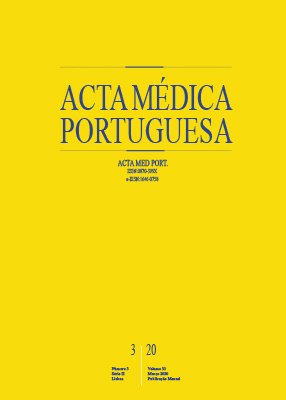The Age of Multidrug Resistance: Ten Year Incidence in a Neonatal Intensive Care Unit
DOI:
https://doi.org/10.20344/amp.12504Keywords:
Drug Resistance, Multiple, Bacterial, Infant, Newborn, Intensive Care Units, Neonatal, PortugalAbstract
Introduction: The emergence of multidrug-resistant bacteria is a medical challenge nowadays. The objective of the present study was to determine the incidence of multidrug-resistant bacteria infections in a neonatal Intensive Care unit.
Material and Methods: Retrospective, descriptive, incidence study of infectious episodes by multidrug-resistant bacteria from 2008 to 2017 in a differentiated perinatal support unit.
Results: Sixty-four infectious episodes included (median gestational age of 28 weeks and birth weight of 885 g). The isolated bacteria were: Enterobacteriaceae (n = 46); Methicillin-resistant Staphylococcus aureus (n = 12); Acinetobacter baumannii (n = 4); Pseudomonas aeruginosa (n = 2). A risk factor was identified in 90.6% of the episodes, with emphasis on central catheter (89%) and previous antibiotic therapy (78%). The lethality rate of these infections was 10.9% (Unit mortality rate: 4.4%). The overall incidence rate was 3.2 infectious episodes/100 hospitalizations, corresponding to 1.7 episodes/1000 days of hospitalization. There were three infectious outbreaks, with an increasing impact of Enterobacteriaceae.
Discussion: The reported incidence rate reflects a risk population, hospitalized in an Intensive Care unit, over a long period of time. The distribution of isolated bacteria, with Enterobacteriaceae predominance, is in accordance with the shift in multidrug resistance reported worldwide. The outbreaks point to the need of understanding risk factors and means of local dissemination. The relevance of these infections is evident in their lethality rate, which is higher compared to that of general hospital infections.
Conclusion: The incidence rate reflects the local dimension of the problem, representing a quality indicator which is relevant for controlling these infections.
Downloads
Downloads
Published
How to Cite
Issue
Section
License
All the articles published in the AMP are open access and comply with the requirements of funding agencies or academic institutions. The AMP is governed by the terms of the Creative Commons ‘Attribution – Non-Commercial Use - (CC-BY-NC)’ license, regarding the use by third parties.
It is the author’s responsibility to obtain approval for the reproduction of figures, tables, etc. from other publications.
Upon acceptance of an article for publication, the authors will be asked to complete the ICMJE “Copyright Liability and Copyright Sharing Statement “(http://www.actamedicaportuguesa.com/info/AMP-NormasPublicacao.pdf) and the “Declaration of Potential Conflicts of Interest” (http:// www.icmje.org/conflicts-of-interest). An e-mail will be sent to the corresponding author to acknowledge receipt of the manuscript.
After publication, the authors are authorised to make their articles available in repositories of their institutions of origin, as long as they always mention where they were published and according to the Creative Commons license.









